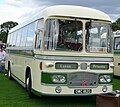Bristol MW
| Bristol | |
|---|---|

Bristol MW with coach body from ECW |
|
| Bristol MW | |
| Manufacturer | Bristol Commercial Vehicles |
| design type | Public bus |
| Production period | 1957-1967 |
| axes | 2 |
| length | 9.1 m |
| width | 2.4 m |
| Seats | 30–45 depending on the structure |
| Previous model | Bristol LS |
| successor |
Bristol RE Bristol LH |
| Similar models | Leyland leopard |
The Bristol MW was a chassis for buses and coaches built by Bristol Commercial Vehicles in England . The type was built between 1957 and 1967. The type designation stood for M edium W eight (medium). It was the successor to the Bristol LS . Replaced by the Bristol RE starting in 1962 , the chassis was produced until 1967.
Superstructures from various coachbuilders were placed on the chassis supplied by Bristol . This construction method was common at the time, as the superstructures could be better adapted to the wishes and ideas of the various bus line operators. The body of the bus was a coach with 30 to 41 seats, a city bus with 30 to 45 seats and a multi-purpose bus with 39 to 43 seats. These multi- purpose buses, referred to as dual purpose in England , were relatively widespread at the time, as they could be used for regular services during the working week and for excursions at times of low traffic. The superstructures mostly came from the Eastern Coach Works (ECW), which were connected to Bristol Commercial through the joint holding company Transport Holding Company . A few buses, which were intended for Scottish operators, also received bodies by the Walter Alexander Coachbuilders .
The Bristol MW was equipped with engines from Gardner . Five or six-cylinder diesel engines of the type 5HLW and 6HLW were used, and the buses were consequently given the type designation MW5G and MW6G. While the smaller engine had a displacement of 7.0 liters, the larger engine had a displacement of 8.4 liters. Although Bristol Commercial Vehicles was itself a major manufacturer of commercial vehicle engines , only one bus was experimentally fitted with a Bristol BHW engine and designated the MW6B. The bus was later converted to a six-cylinder Gardner engine . The engine was arranged horizontally under the floor between the axles. This achieved a level floor for the structure. What was more important, however, was that the front door could be placed in the front overhang. This enabled the cost-saving one-man operation, as the driver could also take over the cashing of the passengers when boarding. The relatively tall engines required steps in the front door. A five-speed synchronized gearbox from Bristol Commercial was used as the transmission, but the synchronization did not always work satisfactorily in practice. The rear axle was available with three different ratios of 5: 1, 5.5: 1 and 6: 1. The chassis was designed to meet the then UK size restrictions for buses 8 feet wide and 30 feet long. After lifting these restrictions, Bristol Commercial did not modify the chassis, but instead developed the rear-wheel drive successor, the Bristol RE . In 1962, however, major changes to the chassis were necessary when air suspension was offered as an option . In addition to the greater comfort for the passengers, the stress on the chassis and body was also lower, which led to a longer service life of assemblies and thus to lower maintenance costs. However, this was offset by a higher purchase price. The air suspension was only offered for coaches and was not particularly successful commercially, only Bristol Omnibus procured a large number of these buses. During the production time, the equipment of the bus was modified several times, in particular the cooling was continuously improved. In addition to a thermostatically controlled electric cooling fan in the front of the bus, a system was later used that heated the cooling water using the exhaust gases. This should allow the engine to reach operating temperature more quickly. Overall, these measures served to minimize fuel consumption and engine wear.
A total of 1965 buses were built, of which 741 MW5G and 1224 MW6G. The largest operator was United Automobile with 262 buses. Bristol Omnibus , Crosville and Red & White also had more than 200 Bristol MW in operation. A few buses are currently still in use in public transport in Malta .
literature
- Curtis, Martin: Bristol Buses in Camera , Ian Allen, 1984. ISBN 0-7110-1361-6
- Townsin, Alan: The Bristol Story Part Two , Venture Publications, 2000. ISBN 1-898432-78-3
Web links
- The Bristol MW site (English)
- History of Bristol Commercial Vehicles by Alan Macfarlane (English)
- Register (worldwide) (English)
- Register and image gallery of the buses in Malta (English)




